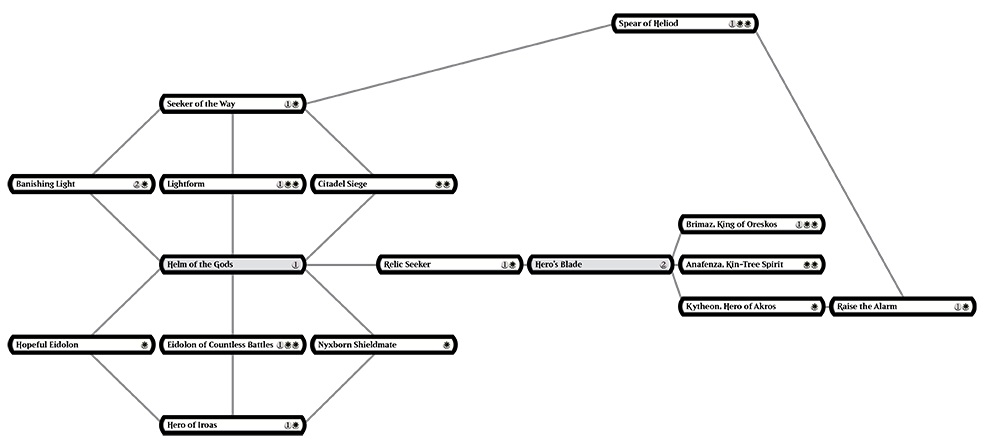As we all know, Magic is a game of interactions rather than cards. It’s odd, then, that most people seem to think about deckbuilding as a collection of cards. I don’t think you have to do it this way, and in fact I think the key to being able to build your own decks is to start identifying clusters and thinking of decks in terms of clusters.
A cluster is a group of cards that work well together – a package of cards that each only make sense when several of them are together. To give some examples from current Standard, Silumgar’s Scorn, Dragonlord Ojutai, Silumgar, the Drifting Death, and Foul-Tongue Invocation represent a Dragon cluster that can be included in or omitted from a control deck, which gives us the distinction between Esper Dragons and U/B Control. Den Protector and Deathmist Raptor are a tight pairing that form the basis of several clusters – Satyr Wayfinder plays well with both of them, and so it often gets pulled into a deck as part of this cluster. Deathmist Raptor likes other morphs while Den Protector likes cheap spells, so the cluster can branch out from there.
One can imagine a giant map of all the cards they’re considering for a deck, with links indicating which cards play well with other cards. Maybe something like this for white aggro in upcoming Standard:
This is just the beginning of the map, which escalates in complexity very quickly.
If one has a properly-constructed map of all the cards in Standard, one could theoretically choose any starting point and then build a cohesive deck by following lines on the map. Instead of building a deck, you’re essentially choosing to play a region on the map – in the map above, I imagine two different Relic Seeker decks, one centered on the Helm of the Gods region and one centered on the Hero’s Blade region.
Let’s expand this to building white aggro decks with spoiled cards from Magic Origins for the upcoming Standard.
The traditional way of thinking about building an aggro deck is to figure out roughly what you want your curve to look like: “I want twelve one-drops, twelve two-drops, four three-drops, three four-drops, and six other spells” and then choosing the best cards for each of those slots, which would lead to something like:
Creatures (30)
- 4 Knight of the White Orchid
- 4 Soldier of the Pantheon
- 4 Brimaz, King of Oreskos
- 3 Anafenza, Kin-Tree Spirit
- 4 Dragon Hunter
- 4 Kytheon, Hero of Akros
- 4 Relic Seeker
- 3 Archangel of Tithes
Lands (23)
- 23 Plains
Spells (7)

In this case, I started out wanting more two drops and one less land, but I found that there weren’t enough good two drops in mono-white so I added a land and some four drops because Archangel of Tithes is probably great. The lack of two-drops also pushed me into playing Relic Seeker, which was fine because the package of Legends happens to also include the highest power-level cards.
The way that I tend to build decks is something more like, “I think Helm of the Gods might be good, I should try to build around that.” Then I brainstorm the part of the cluster that surrounds that card:
One Mana
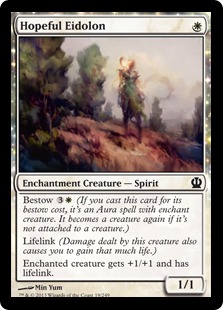
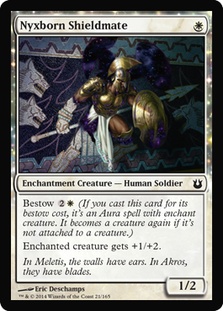
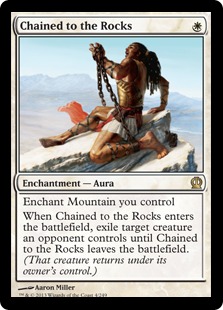
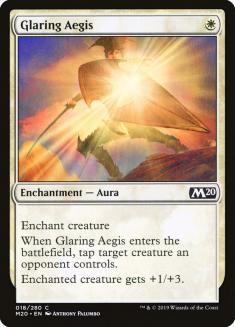
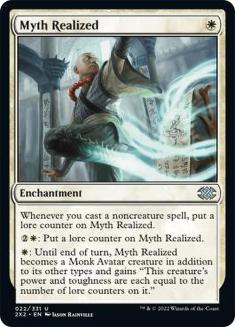
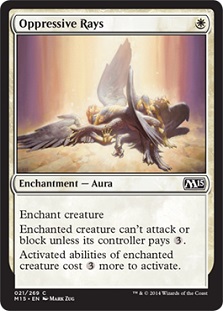
Two Mana
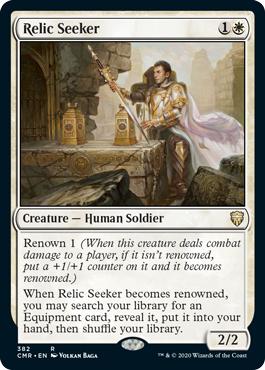
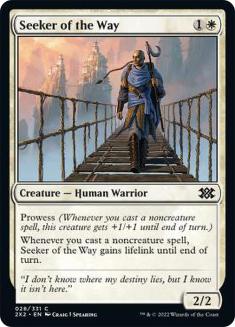
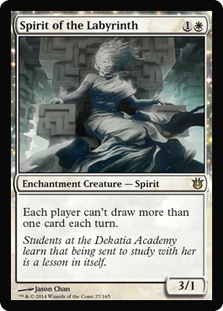
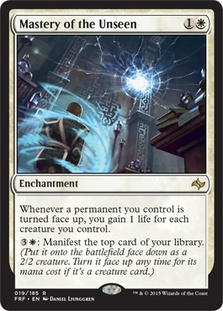
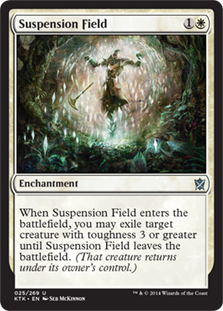
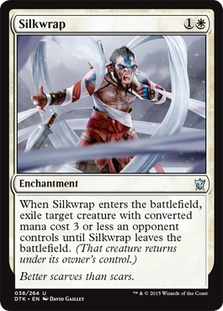
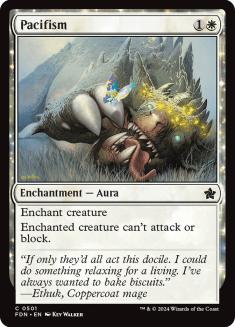

Three Mana
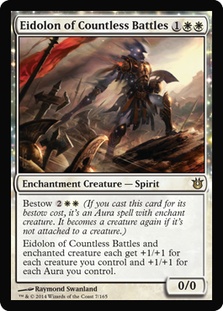
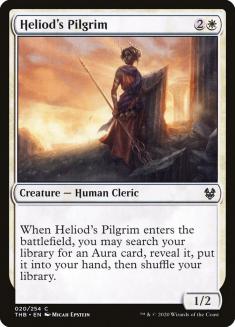
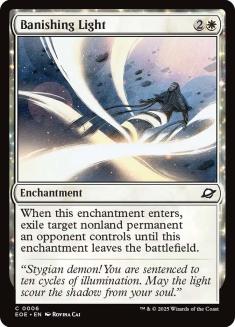
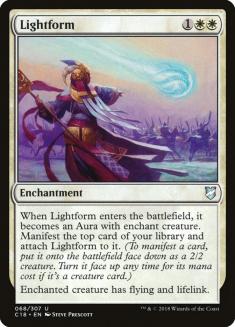
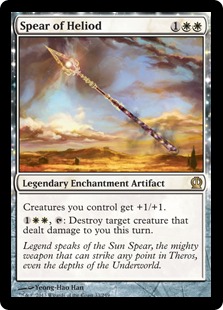
Four Mana
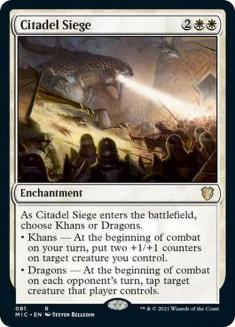
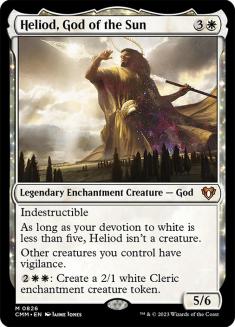
Five Mana

This is a list of white cards, but Chained to the Rocks only works if I’m also red, which brings in an entire extra list of cards
From there I have to pare this down to a deck, or, possibly trim it further into a cluster, which I could combine with other cards from outside the cluster to form a deck – most often, part of a deck will contain part of a cluster – it’s rare that an entire deck is made from a single cluster, and rare that an entire cluster fits into a deck.
Note that this group of cards connected to Helm of the Gods includes tighter sub-clusters, like Heliod’s Pilgrim with the various Auras that I’ve listed as bullets, all of which also specifically support getting Relic Seeker to connect.
Further, many cards in this cluster point to cards that don’t directly connect to Helm of the Gods – for example, all the Bestow creatures are in a different known cluster with Hero of Iroas, so if I build around them I’d likely also want to play Hero of Iroas.
Some cards, like Spear of Heliod, are easy to identify as somewhat out of place – I know that Spear of Heliod is part of a cluster of cards that reward a “go wide” strategy that loading up on enchantments instead of creatures and token makers doesn’t support, and I already have better ways of pumping my creatures – most notably, Helm of the Gods.
At the same time, I can identify that Eidolon of Countless Battles also likes going wide, and I can note that I could possibly build a deck by combining the enchantment cluster with a token cluster.
So, here would be an example of a deck built around the Bestow cluster:
Creatures (25)
- 2 Soldier of the Pantheon
- 4 Hopeful Eidolon
- 4 Nyxborn Shieldmate
- 4 Hero of Iroas
- 4 Spirit of the Labyrinth
- 3 Eidolon of Countless Battles
- 4 Relic Seeker
Lands (23)
- 23 Plains
Spells (12)

I like Seeker of the Way because it’s very good to Bestow onto and good to equip, but Hero of Iroas and Relic Seeker seemed more important and I wanted to minimize my non-enchantments. Also, I should have enough lifelink between Hopeful Eidolon and Lightform that I won’t need it.
Lightform is great with Helm of the Gods, but really amazing if I hit Relic Seeker with it.
I’m not playing Kytheon, Hero of Akros because my desire to Bestow means I often won’t have three creatures on the battlefield, so I think I get more out of Soldier of the Pantheon.
I could build around Heliod’s Pilgrim instead:
Creatures (18)
- 4 Soldier of the Pantheon
- 4 Heliod's Pilgrim
- 4 Seeker of the Way
- 3 Kytheon, Hero of Akros
- 3 Relic Seeker
Lands (23)
- 23 Plains
Spells (19)

This build is a little all over the place and a little light on enchantments, which is why I trimmed the Helm of the Gods package. It also has to play some fairly weak cards for Heliod’s Pilgrim. If I want to go this direction, I’m likely much better off going R/W:
Creatures (24)
- 4 Hero of Iroas
- 4 Nyxborn Rollicker
- 4 Mogis's Warhound
- 4 Prophetic Flamespeaker
- 2 Heliod's Pilgrim
- 4 Monastery Swiftspear
- 2 Kytheon, Hero of Akros
Lands (19)
Spells (12)

I’m not sure how many enchantments are necessary to make Helm of the Gods good, but it doesn’t seem like it should be very many since the card is very good if you have two enchantments and outstanding if you have three or more. Sketching out these decks, I find something always has to give, and here I gave up on Relic Seeker; instead, I’m focusing on pumping Prophetic Flamespeaker. I have no idea if Kytheon’s actually any good in this deck, but I figured it’s worth trying with a low curve that includes haste creatures.
While I’m on the subject of R/W, another way to build it is to focus on pushing Renown creatures there. Kytheon, of course, is functionally a Renown creature since he has to live through combat in order to ignite Gideon’s spark, which likely means dealing combat damage to a player. R/W is a great pairing for this due to the abundance of cheap red creature removal, but I’m also interested in Subterranean Scout as an easy way to get a creature through any blockers. I think Subterranean Scout will mostly end up being known as the creature that gets Goblin Piledriver through, but it also has applications with Renown creatures.
Creatures (25)
- 4 Goblin Piledriver
- 4 Foundry Street Denizen
- 4 Goblin Rabblemaster
- 1 Zurgo Bellstriker
- 4 Subterranean Scout
- 4 Kytheon, Hero of Akros
- 4 Goblin Glory Chaser
Lands (21)
Spells (14)

This could easily be worse than a mono-red take on Goblins, but Kytheon, Hero of Akros could be great here. This gives us a deck that’s very weak against sweepers and real resistance, but Chained to the Rocks plays really well in this deck, offering a cheap way to clear any blocker, making it much easier to connect with Goblin Piledriver or Goblin Rabblemaster, and answering creatures that are too big to burn.
Getting back to white, it’s hard not to notice how much Devotion has been pushed in this set. The problem with White Devotion has always been finding the right payoff rather than the right enablers, but maybe there’s something here:
Creatures (21)
- 4 Knight of the White Orchid
- 1 Heliod, God of the Sun
- 2 Ephara, God of the Polis
- 4 Brimaz, King of Oreskos
- 3 Dragonlord Ojutai
- 3 Anafenza, Kin-Tree Spirit
- 4 Archangel of Tithes
Planeswalkers (3)
Lands (25)
Spells (11)

Heliod is a very weak card, but granting vigilance plays well with Archangel of Tithes and Dragonlord Ojutai while making tokens plays well with Ephara, God of the Polis, which also plays well with Master of the Unseen, which is obviously great with Nykthos, Shrine to Nyx. Knight of the White Orchid only sometimes finds a land, but it always offers a good rate for Nykthos. Between Elspeth, Sun’s Champion, Secure the Wastes, Heliod, and Ephara, this deck is very good at using mana from Nykthos.
Anafenza, Kin-Tree Spirit doesn’t work with tokens from Secure the Wastes, Brimaz, King of Oreskos, Elspeth, or Heliod, but it is great with Mastery of the Unseen.
Finally, like Heliod, Secure the Wastes, and Mastery of the Unseen, Brimaz, King of Oreskos is great with Ephara.
I didn’t bother with one-drops in this deck because there’s a good chance that 2/1s will continue to match up poorly against the token makers of this format and they don’t offer much towards Devotion. Instead, I’m just trying to go bigger.
The most important thing to understand about using clusters in your thinking about deckbuilding is it’s most valuable when it comes to changing a deck. When you’re testing a deck, you’ll often find cards that aren’t working, but if you cut some of them, you need to understand any links you might be breaking, what cards might be left stranded. Likewise, when looking for cards to replace them with, you’ll want to be aware of other cards that are adjacent in clusters to cards that are in your deck, but aren’t currently in the 60. Also, sometimes you’ll find that a particular cluster of cards isn’t working in your deck and you can just swap out that entire cluster for a different cluster that fills the same role.
My favorite example of this came when I was building The Aristocrats for Pro Tour Gatecrash. I’d tested it originally as a Mardu Zombies deck that included the same sacrifice theme, with Cartel Aristocrat, Falkenrath Aristocrat, and Blood Artist but using Gravecrawler as my fodder with cards like Diregraf Ghoul to support it. I found that Zombies’ weakness at blocking was too costly because it took me too long to set up against other aggressive decks. Rather than scrapping my deck entirely, I recognized that I could just remove the Zombie package that I’d included to fill the role of fodder for my Aristocrats and replace them with a Human cluster involving Doomed Traveler and Champion of the Parish instead, which would keep my curve similar and still give me small creatures to sacrifice while letting me play a better defensive game while I got all my parts together.
Whenever you’re working on a deck, pay attention to which cards need each other and which parts of your deck are working well. Think of testing a deck as testing the clusters contained within that deck and identify which clusters work well and which don’t; that will allow you to build new decks that are well-positioned by combining the correct clusters from other decks to attack the metagame you’re presented with.

